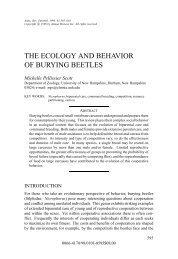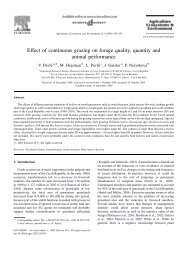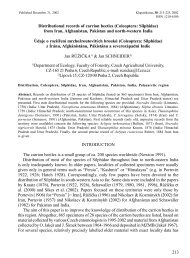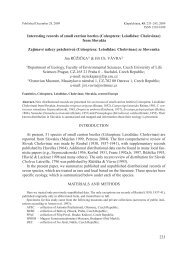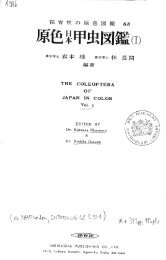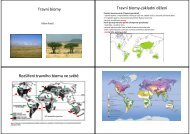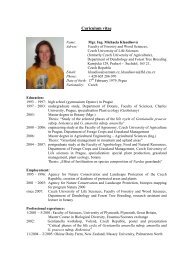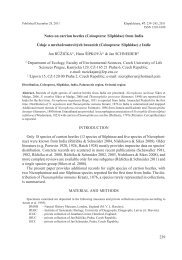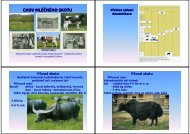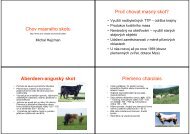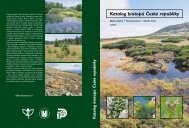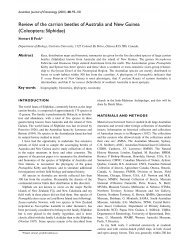- Page 7: HistoryLinnaeus named two species o
- Page 11 and 12: ETHZ Entomologisches Institut, Eidg
- Page 13 and 14: particular, was enormously simplifi
- Page 15: unnipes Gradl, 1882; as var. interr
- Page 19 and 20: spinipes Leach, 1815; = Nicrophorus
- Page 21 and 22: =Necrophorus (Necrophorindus) Semen
- Page 23 and 24: 1933 Semenov-Tian-Shanskij: 150 (ca
- Page 25 and 26: 1996 Downie & Arnett: 356 (key, des
- Page 27 and 28: the condition of article 23.9.1.1.
- Page 29 and 30: Comments: Lectotype data for Nicrop
- Page 31 and 32: Type depository: BMNH: London [!] h
- Page 33 and 34: 1877 Harold: 345 (descriptions in G
- Page 35 and 36: 1840 Laporte: 2 (descriptions in Fr
- Page 37 and 38: 1893 Heyden: 51 (checklist in Germa
- Page 39 and 40: 1975 Emetz & Schawaller: 231 (check
- Page 41 and 42: 1914b Portevin: 224 (description of
- Page 43 and 44: 1910 Jakobson: 612 (checklist in Ru
- Page 45 and 46: 1920 Leng: 86 (catalog) >> as N. ve
- Page 47 and 48: Comments: Lectotype data for Nicrop
- Page 49 and 50: Nicrophorus distinctus Grouvelle, 1
- Page 51 and 52: 1841b Heer: 9 (checklist in German)
- Page 53 and 54: 1936 Mosebach: 223 (morphology, lar
- Page 55 and 56: 1880 Kraatz: 117 (description of va
- Page 57 and 58: 1883 Heyden et al.: 73 (checklist)
- Page 59 and 60:
1898 Everts: 4121906 Heyden et al.:
- Page 61 and 62:
1909 Bickhardt: 73 (description of
- Page 63 and 64:
1928 Hatch: 146 (catalog) >> Miside
- Page 65 and 66:
1949 Pierce: 66 (fossils, descripti
- Page 67 and 68:
1807 Haworth: 82 (descriptions) >>
- Page 69 and 70:
1913 Kuhnt: 335 (in German)1914 Gor
- Page 71 and 72:
1972b Ernst: 96 (morphology: antenn
- Page 73 and 74:
1995 Dapsio: 120 (checklist in Lith
- Page 75 and 76:
1893 Reitter: 147 (key, description
- Page 77 and 78:
Nicrophorus insularis Grouvelle, 18
- Page 79 and 80:
1891 Heyden et al.: 138 (checklist)
- Page 81 and 82:
1996 Pushkin: 33 (biology, ecology
- Page 83 and 84:
= corsicus Laporte, 1832 NEW STATUS
- Page 85 and 86:
1883 Heyden et al.: 73 (checklist)
- Page 87 and 88:
1996 Hansen: 93 (checklist, distrib
- Page 89 and 90:
1965 Báguena: 51 (checklist in Spa
- Page 91 and 92:
1891 Heyden et al.: 139 (checklist)
- Page 93 and 94:
The name N. algiricus was given by
- Page 95 and 96:
1934b Pukowski: 53-60 (morphology,
- Page 97 and 98:
1985 Zahradník: 123 (catalog, anno
- Page 99 and 100:
2001 Smith et al.: 148-154 (biology
- Page 101 and 102:
1884 Reitter: 87 (descriptions in G
- Page 103 and 104:
1906 Heyden et al.: 247 (checklist)
- Page 105 and 106:
1857b Gistel: 565 (in German) >> as
- Page 107 and 108:
1873 Crotch: 37 (checklist) >> as S
- Page 109 and 110:
1845a Motschulsky: 54 (descriptions
- Page 111 and 112:
1966c Mroczkowski: 437 (checklist)
- Page 113 and 114:
1934b Pukowski: 54 (morphology, lar
- Page 115 and 116:
"in east Siberia there is a species
- Page 117 and 118:
1936 Cho: 155 (checklist in Korean)
- Page 119 and 120:
1923 Portevin: 309 (key, descriptio
- Page 121 and 122:
1963 Nakane: 75 (checklist, brief d
- Page 123 and 124:
Nicrophorus marginatus Fabricius, 1
- Page 125 and 126:
1979 Miller & Peck: 96 (fossils)197
- Page 127 and 128:
= mckittricki Pierce, 1949 [fossil]
- Page 129 and 130:
1996 Halffter et al.: 162 (biology,
- Page 131 and 132:
ate pin with label "47"; "Coll. Sem
- Page 133 and 134:
1874 Solsky: 213 (checklist in Russ
- Page 135 and 136:
1893 Heyden: 51 (checklist in Germa
- Page 137 and 138:
= benguetensis Arnett, 1946 NEW SYN
- Page 139 and 140:
1939 Roubal: 85 (description of var
- Page 141 and 142:
1993 Peck & Miller: 8 (species-grou
- Page 143 and 144:
1853 Melsheimer: 39 (catalog)1854 L
- Page 145 and 146:
Nicrophorus orbicollis Say, 1825Typ
- Page 147 and 148:
1982 Shubeck & Blank (biology, ecol
- Page 149 and 150:
2001 Scott et al.: 295-302 (biology
- Page 151 and 152:
116.07° ' E,](coll. Waterstradt) /
- Page 153 and 154:
1925 Winkler: 263 (catalog)1926a Po
- Page 155 and 156:
2002 Rauter & Moore: 96 (biology, b
- Page 157 and 158:
1993b Kozminykh: 67 (key, descripti
- Page 159 and 160:
1933 Semenov-Tian-Shanskij: 156 (ca
- Page 161 and 162:
1930 Kieseritzky: 60 (descriptions
- Page 163 and 164:
1909 Stevens: 106 (biology, cytolog
- Page 165 and 166:
1870 LeConte: 398 (nomenclature) >>
- Page 167 and 168:
1910 Jakobson: 612 (checklist in Ru
- Page 169 and 170:
1993b Kozminykh: 65 (key, descripti
- Page 171 and 172:
1901 Carret: 331 (description of va
- Page 173 and 174:
1854 Lacordaire: 199 (biology, cata
- Page 175 and 176:
1992 Ôhara & Yabuki: 57 (checklist
- Page 177 and 178:
1910 Smith: 229 (checklist)1911 Wic
- Page 179 and 180:
1989 Scott & Traniello: 32-36 (popu
- Page 181 and 182:
1928 Hatch: 147 (catalog) >> as syn
- Page 183 and 184:
1925 Winkler: 263 (catalog)1926a Po
- Page 185 and 186:
1824 Zetterstedt: 151 (descriptions
- Page 187 and 188:
1916 Labitte: 9 (biology in French)
- Page 189 and 190:
1970 Gersdorf: 366 (morphology: fem
- Page 191 and 192:
1997 Anderson et al.: 14 (checklist
- Page 193 and 194:
= fauveli Fauconnet, 1893 NEW STATU
- Page 195 and 196:
1944 Arnett: 4 (morphology: female
- Page 197 and 198:
1926 Porta: 333 (key, checklist in
- Page 199 and 200:
1970 Franz: 214 (checklist, distrib
- Page 201 and 202:
1989 Lafer: 338 (key, descriptions,
- Page 203 and 204:
1999 Bertin & Lebboroni: 58 (checkl
- Page 205 and 206:
1997 Krivolutskaya: 3 (checklist) >
- Page 207 and 208:
1841b Heer: 9 (checklist in German)
- Page 209 and 210:
1959 Linssen: 162 (catalog) >> as s
- Page 211 and 212:
= sylvaticus Reitter, 1895 CONFIRME
- Page 213 and 214:
1874 Seidlitz: 216 (key in German)1
- Page 215 and 216:
1971 Freude: 194 (key in German)197
- Page 217 and 218:
Type depository: see N. interruptus
- Page 219 and 220:
1884 Reitter: 88 (descriptions in G
- Page 221 and 222:
1837 Erichson: 224 (species-group c
- Page 223 and 224:
1966c Mroczkowski: 435 (checklist)1
- Page 225 and 226:
1868 Gemminger & Harold: 719 (catal
- Page 227 and 228:
1993b Kozminykh: 61 (key, descripti
- Page 229 and 230:
1927b Hatch: 364 (revision: key, de
- Page 231 and 232:
(biology, conservation) [First publ
- Page 233 and 234:
Backlund, D.C. & Marrone, G.M. (199
- Page 235 and 236:
Bergsträsser, J.A.B. (1778) Nomenc
- Page 237 and 238:
Böhm, H., Heinzel, H.-G. & Wendler
- Page 239 and 240:
Chenu, J.C. & Desmarest, E. (1851)
- Page 241 and 242:
Curtis, J. (1825) British entomolog
- Page 243 and 244:
Dunn, G.A. (1994) Interesting beetl
- Page 245 and 246:
Evans, M.E.G. (1969) The surface ac
- Page 247 and 248:
Fleischer, A. (1912) Neue Aberratio
- Page 249 and 250:
vespillo); N. interruptus Gistel ne
- Page 251 and 252:
Hanski, I. & Krikken, J. (1991) Dun
- Page 253 and 254:
Herms, W. (1899) Necrophorus humato
- Page 255 and 256:
voisines Anatomie générale; class
- Page 257 and 258:
Katakura, H. & Fukuda, H. (1975) Fa
- Page 259 and 260:
Kôno, H. (1935) Insects of Jehol [
- Page 261 and 262:
Kraatz, G. (1876c) Ueber das Artrec
- Page 263 and 264:
LeConte, J.L. (1859b) Additions to
- Page 265 and 266:
Lucht, W.H. (1987) Die Käfer Mitte
- Page 267 and 268:
McAtee, W.L. (1918) Food habits of
- Page 269 and 270:
Motschulsky, V. (1859a) Coléoptèr
- Page 271 and 272:
Nagano, M. & Hoshina, H. (2001) Rep
- Page 273 and 274:
Núñez, E., Tizado, E.J., Salgado,
- Page 275 and 276:
Pardo-Alcaide, A. & Yus, R. (1975)
- Page 277 and 278:
Pic, M. (1917b) Notes diverses, des
- Page 279 and 280:
Preyssler, J.D.E. (1790) Verzeichni
- Page 281 and 282:
Reitter, E. (1883) Ueber die Verbre
- Page 283 and 284:
Roubal, J. (1930) [“1930-1936”]
- Page 285 and 286:
Say, T. (1825) Descriptions of new
- Page 287 and 288:
Schwarz, C. (1793) Nomenclator übe
- Page 289 and 290:
[Suggests role of increase in JH up
- Page 291 and 292:
Shubeck, P.P. & Schleppnik, A.A. (1
- Page 293 and 294:
Staines, C.L., Jr. (1989) Additiona
- Page 295 and 296:
Takaku, G., Katakura, H., & Yoshida
- Page 297 and 298:
Trumbo, S.T. & Fernandez, A.G. (199
- Page 299 and 300:
Wickham, H.F. (1911) A list of the
- Page 301 and 302:
Index to genus- and species-group n
- Page 303 and 304:
Index (continued)Nicrophorusobrutor



